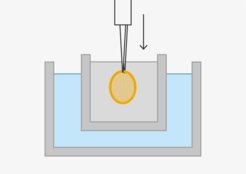Sample vitrification

Biological material needs to be fixed prior to EM imaging. Chemical fixation can introduce artefacts that disturb the ultrastructure of biological samples. In cryofixation, samples are frozen so quickly that water molecules do not have time to form ice crystals, thereby preserving the sample in a near-native state. Various techniques exist, such as plunge-freezing, jet-freezing and high-pressure freezing. The most common method of cryofixation is plunge-freezing, where the sample is plunged rapidly in a cryogen such as liquid ethane cooled by liquid nitrogen. We have various types of plunge freezing systems available, Thermo Scientific Vitrobot Mk IV, Leica EM GP2 and several custom-made systems. Plunge-freezing is suited for thin samples such as protein complexes, organelles and small cells. In jet-freezing, samples are vitrified with a jet of cold ethane directed to the sample. Our facility operates a CryoSol Vitrojet, which pin-prints a sample onto the carrier prior to jet-freezing with ethane. For larger samples such as large mammalian cells or tissue, vitrification can only be achieved by high-pressure freezing (HPF). Applying high pressure increases the temperature at which water adopts a vitreous state and therefore avoids ice crystallisation in larger sample volumes. After HPF, samples can be used for further cryo-microscopy (for example cryoFIB-milling), or their water content can be freeze-substituted with a solvent prior to sample embedding in a resin. For HPF, we use a Leica EM ICE high pressure freezer and for freeze substitution, we use a Leica EM AFS2 with an FSP automated reagent handling system.
